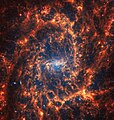NGC 2835
| Galaxie NGC 2835 | |
|---|---|
 | |
| Aufnahme des Hubble-Weltraumteleskops | |
| AladinLite | |
| Sternbild | Wasserschlange |
| Position Äquinoktium: J2000.0, Epoche: J2000.0 | |
| Rektaszension | 09h 17m 52,6s[1] |
| Deklination | −22° 21′ 19″[1] |
| Erscheinungsbild | |
| Morphologischer Typ | SAB(rs)c / HII[1] |
| Helligkeit (visuell) | 10,3 mag[2] |
| Helligkeit (B-Band) | 11,0 mag[2] |
| Winkelausdehnung | 6,6′ × 4,4′[2] |
| Positionswinkel | 8°[2] |
| Flächenhelligkeit | 13,8 mag/arcmin²[2] |
| Physikalische Daten | |
| Zugehörigkeit | LGG 172[1][3] |
| Rotverschiebung | 0,002959 ± 0,000002[1] |
| Radialgeschwindigkeit | (887 ± 1) km/s[1] |
| Hubbledistanz H0 = 73 km/(s • Mpc) | (30 ± 2) · 106 Lj (9,3 ± 0,7) Mpc [1] |
| Durchmesser | 60.000 Lj[4] |
| Geschichte | |
| Entdeckung | Ernst Wilhelm Tempel |
| Entdeckungsdatum | 13. April 1884 |
| Katalogbezeichnungen | |
| NGC 2835 • UGC A 157 • PGC 26259 • ESO 564-35 • MCG -04-22-008 • IRAS 09156-2208 • 2MASX J09175290-2221168 • SGC 091537-2208.7 • AM 0915-220 • HIPASS J0917-22 | |
NGC 2835 ist eine Balken-Spiralgalaxie mit ausgedehnten Sternentstehungsgebieten vom Hubble-Typ SBc im Sternbild Hydra südlich der Ekliptik. Sie ist schätzungsweise 30 Millionen Lichtjahre von der Milchstraße entfernt und hat einen Durchmesser von etwa 70.000 Lichtjahren.
Das Objekt wurde am 13. April 1884 von Ernst Wilhelm Leberecht Tempel entdeckt.[5]
- (c) NASA, ESA, CSA, STScI, J. Lee (STScI), T. Williams (Oxford), PHANGS Team, CC BY 4.0Infrarotaufnahmen mithilfe des James-Webb-Weltraumteleskops
NGC 2835-Gruppe (LGG 172)
| Galaxie | Alternativname | Entfernung/Mio. Lj |
|---|---|---|
| NGC 2835 | PGC 26529 | 30 |
| NGC 2784 | PGC 25950 | 21 |
| PGC 25827 | ESO 497-017 | 23 |
| PGC 26484 | ESO 565-001 | 28 |
Weblinks
- CDS Portal
- SIMBAD Astronomical Database
- astronews
- Eye of the Serpent (engl.)
- Spektrum.de: Amateuraufnahmen [1]
Einzelnachweise
Auf dieser Seite verwendete Medien
Autor/Urheber: Judy Schmidt from USA, Lizenz: CC BY 2.0
A pretty spiral with lots of star formation going on. The blue areas show where near-ultraviolet light is more strongly emitted, indicating recent or ongoing star formation.
Data from the following proposal were used to create this image: PHANGS-HST: Linking Stars and Gas throughout the Scales of Star Formation
Red: WFC3/UVIS F814W Green: WFC3/UVIS F555W Blue: WFC3/UVIS F438W+F336W+F275W
North is 4.50° clockwise from up.(c) NASA, ESA, CSA, STScI, J. Lee (STScI), T. Williams (Oxford), PHANGS Team, CC BY 4.0
This spiral galaxy was observed as part of the Physics at High Angular resolution in Nearby GalaxieS (PHANGS) program, a large project that includes observations from several space- and ground-based telescopes of many galaxies to help researchers study all phases of the star formation cycle, from the formation of stars within dusty gas clouds to the energy released in the process that creates the intricate structures revealed by Webb’s new images.NGC 2835 is 35 million light-years away in the constellation Hydra.Learn more about what can be seen in this vast collection of Webb images here.[Image description: Webb’s image of NGC 2835 shows a densely populated face-on spiral galaxy anchored by a central region that is bright blue. The spiral arms appear muddled, but it is possible to pick out individual spiral arms. The arms extend to the edges and rotate counterclockwise.]


